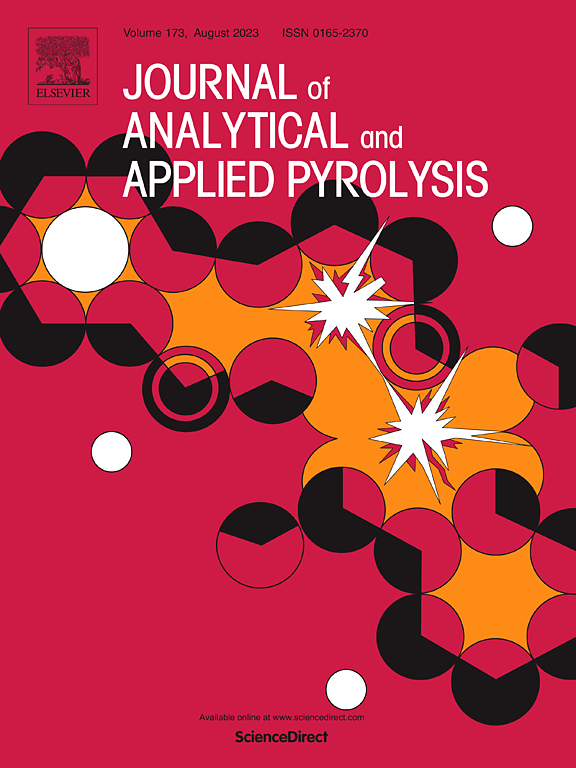Co-pyrolysis of bamboo with low-dose guanidine phosphate to synthesis heteroatom-enriched porous carbon materials for supercapacitors
IF 5.8
2区 化学
Q1 CHEMISTRY, ANALYTICAL
引用次数: 0
Abstract
The conversion of biomass-derived waste into functional carbon materials for application in electrochemical energy storage represents a promising strategy towards green and low-carbon production methods. Incorporating environmentally benign flame retardants as dopants in the co-pyrolysis of biomass to carbon materials offers a novel pathway for fabricating hierarchical porous structures with tailored heteroatom functional groups. This study pioneers a sustainable strategy to convert bamboo waste into heteroatom-doped hierarchical porous carbon for supercapacitors via a two-stage pyrolysis, using eco-friendly nitrogen-phosphorus flame retardants as dual-functional dopants. By integrating guanidine phosphate into bamboo co-pyrolysis (300°C, GP/bamboo ratio 1:2) followed by KHCO3 activation, the optimal GB12 achieves 387 F/g at 0.5 A/g and 300 F/g at 20 A/g with 77.52 % capacitance retention, outperforming conventional doping methods. Remarkably, low-dose GP doping enables synergistic pore engineering (specific surface area of 1545.8 m²/g) and heteroatom functionality (3.42 % N, 0.49 % P), yielding a symmetric supercapacitor with 8.82 Wh/kg energy density at 125 W/kg. With exceptional electrochemical performance, GB12 demonstrated that low doses of nitrogen-phosphorus flame retardants can achieve remarkable pore formation and heteroatom doping effects. This work redefines flame retardants as efficient carbon activators, establishing a scalable biomass-to-electrode paradigm for advanced energy storage.
竹材与小剂量磷酸胍共热解制备超级电容器用富杂原子多孔碳材料
将生物质废弃物转化为用于电化学储能的功能碳材料是一种有前途的绿色低碳生产方法。将环保型阻燃剂作为掺杂剂加入生物质共热解制碳材料中,为制造具有定制杂原子官能团的分层多孔结构提供了一条新途径。本研究开创了一种可持续的策略,通过两阶段热解将竹废料转化为杂原子掺杂的分层多孔碳,用于超级电容器,使用环保的氮磷阻燃剂作为双功能掺杂剂。将磷酸胍加入竹材共热解(300℃,GP/bamboo比1:2)中,再进行KHCO3活化,得到最佳的GB12在0.5 A/g和20 A/g下的电容保有率分别为387 F/g和300 F/g,电容保有率77.52 %,优于常规掺杂方法。值得注意的是,低剂量GP掺杂可以实现协同孔隙工程(比表面积为1545.8 m²/g)和杂原子功能(3.42 % N, 0.49 % P),从而产生能量密度为8.82 Wh/kg,能量密度为125 W/kg的对称超级电容器。GB12具有优异的电化学性能,表明低剂量的氮磷阻燃剂可以实现显着的孔隙形成和杂原子掺杂效应。这项工作将阻燃剂重新定义为高效的碳活化剂,为先进的能源储存建立了可扩展的生物质-电极模式。
本文章由计算机程序翻译,如有差异,请以英文原文为准。
求助全文
约1分钟内获得全文
求助全文
来源期刊
CiteScore
9.10
自引率
11.70%
发文量
340
审稿时长
44 days
期刊介绍:
The Journal of Analytical and Applied Pyrolysis (JAAP) is devoted to the publication of papers dealing with innovative applications of pyrolysis processes, the characterization of products related to pyrolysis reactions, and investigations of reaction mechanism. To be considered by JAAP, a manuscript should present significant progress in these topics. The novelty must be satisfactorily argued in the cover letter. A manuscript with a cover letter to the editor not addressing the novelty is likely to be rejected without review.

 求助内容:
求助内容: 应助结果提醒方式:
应助结果提醒方式:


